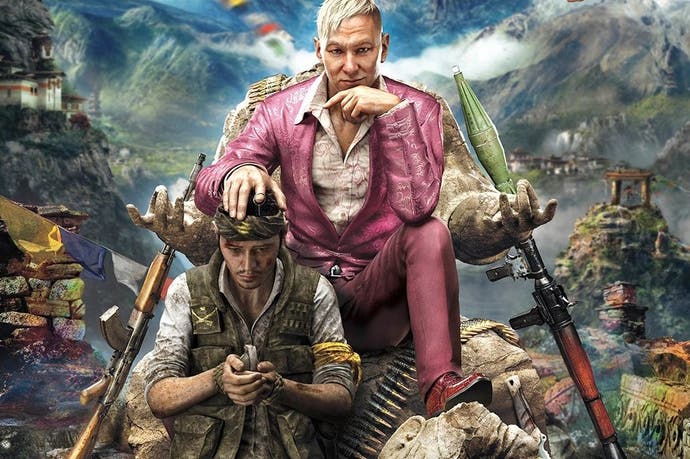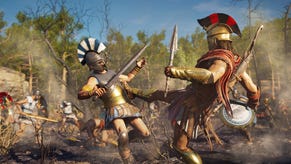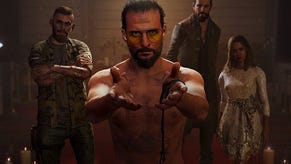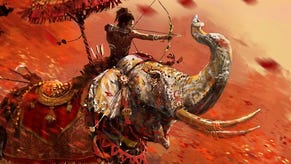Far Cry 4 review
Kyrati kid.
If a tree falls in a forest and no one is around to hear it, does it still make a sound? If I strap a wodge of C4 to a tuk-tuk and send it trundling off a cliff and into a mountainside military base while hopping aboard a gyrocopter and luring a tiger into the midst of a crowd of armed guards with a piece of meat I've freshly carved from a yak, does the chaos that ensues even count if there's no-one else around to appreciate it?
Among the great joys of 2012's Far Cry 3 were the anecdotes you accumulated just by stepping outside any spawn point and heading off into the wilderness with naught but your grenade launcher for company - but save for sharing any videos you might have made, you were always the sole witness to these feats of derring-do. Far Cry 4 aims to address this with not only a 5v5 multiplayer component, but a two-player co-op mode that allows you to invite a friend to accompany you on your excursions through Kyrat, its fictional setting in the Himalayan mountains.
During co-op sessions, Far Cry 4's main story campaign isn't accessible, but nearly everything else is. Given how little time developer Ubisoft Montreal devotes to protagonist Ajay and his impromptu cultural exchange, you wonder if it wouldn't have rather skipped the formality of a single-player campaign entirely, instead letting you loose on the local populace with a bunch of new toys and allowing you to have at it. It's just a shame the playground isn't nearly as compelling as its predecessor's was.
Tom Bramwell wrote in his 10/10 Far Cry 3 review that "This vast, mountainous patch of fictional grass and rock in the middle of the Pacific has been created by people who believe that every inch is important, and who have refused to compromise or sculpt any part of it with less than an artist's attention to detail." It's true - turn a corner anywhere in the Rook Islands and you'd be met with a breathtaking vista or a lush patch of jungle that slowly trickled out onto sprawling golden sands. Kyrat may be given a visual boost by the new generation of consoles, and it does boast a few incredibly beautiful locations - gilded temples carved into mountainsides and quiet lakes where incense burns atop makeshift shrines, as well as Shanath Arena, where the crowd tosses coloured dust into the air as it bays for your blood - but for the most part, Kyrat simply isn't as striking a setting as the South Pacific islands of Far Cry 3.
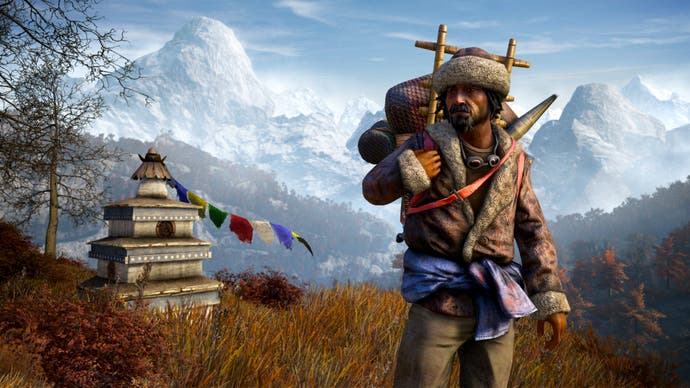
Perhaps sensing this, Ubisoft has included several quest lines that change the landscape considerably. The mystical realm of Shangri-La, where the rivers run red, the sky is gold and the animals are (considerately) uniformly white, is so stunningly beautiful that I'm wondering when it'll receive its own add-on outing. Another quest chain that has Ajay fall in with a couple of backpacking druggies sends him on a series of trips that turn the Himalayan skyline into something resembling an after-school disco, albeit with a few more things on fire.
But when you aren't bugging out or having an out-of-body experience, the vast expanse of land at your disposal gets quite samey. After a few hours skulking along its grey cliffsides and grappling down another weathered rocky outcrop, you begin pining for Rook Islands' glittering coves and vivid, azure lagoons. In Far Cry 3, the landscape was so expertly crafted that I could eventually identify individual landmarks and find my way around through exploration rather than simply following a waypoint. Far Cry 4 actually feels like it suffers from being bigger, with overly lengthy treks needed to get from one place of interest to another until fast travel points are unlocked.
What Kyrat may lack in looks, it makes up for by being positively stuffed with things to do. In terms of side quests, you have assassination missions, hostage rescues, escort quests, resource collecting, bomb defusal, and hunting challenges to name but a few; once you begin liberating Bell Towers, buying maps from Trade Posts and taking control of the region, your map will be beset by location markers, collectables and quest symbols. Answering criticism that there simply wasn't much to do in Far Cry 3 once you'd defeated every enemy encampment, you can now retry taking any outpost after liberating it, attempting different tactics as many times as you like - a comfortable compromise between Far Cry 2's respawning military checkpoints and 3's end-game ghost towns.
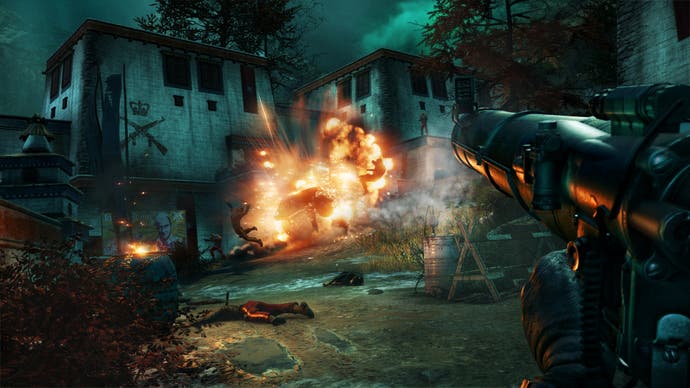
So-called Retaliation Parties will randomly attack outposts you've previously liberated, though you can choose not to intervene if you have more pressing matters to attend to elsewhere. The ability to drag and hide bodies, a feature that was irritatingly missing from 3, has been added, making stealth a more tactical endeavour that's less down to blind luck. You'll need luck, though, if you're to attempt any of the game's four fortresses: souped-up outposts with multiple alarms and more enemies, designed with two players working in tandem in mind.
If you don't have a co-op partner to hand, you can opt to use a Guns for Hire token to call in some AI support. These tokens are earned through Far Cry 4's new Karma system. Your Karma level, which also grants weapon discounts at Trade Posts, is increased through stepping in to protect civilians or Golden Path devotees from Royal Army abductions or wild animal attacks, or from spinning mani wheels that you find dotted throughout the map. Conversely, killing innocents or comrades will lower your Karma - though by barely noticeable amounts, so you won't be penalised too harshly for some NPC stepping into your line of fire.
Ubisoft has considerably ramped up the list of things to see and do, then - but the studio also shies away from its own story. Ajay, a Kyrati native raised in America, has returned to his homeland for the first time in his adult life with the intent to scatter his recently deceased mother's ashes. Soon after touching down, he realises his parents each had a sizable role in instigating the civil war the country is currently embroiled in, a war against its flamboyant and despotic leader, Pagan Min. This dynamic is never really explored outside of optional collectable journal entries from Ajay's father, however, while a revelation regarding the family is casually thrown into a cut-scene and rendered largely meaningless, given that the game spends next to no time explaining Kyrat's more obscure and antiquated religious practices.
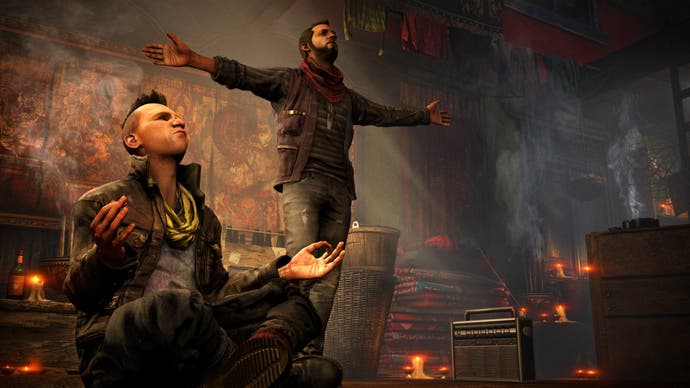
For all Far Cry 3's problematic narrative themes (and there were a few), at least it got people talking. The characters were a fascinating and often repellant bunch: a mad doctor, a pervert, a charismatic if totally insane warlord. In Far Cry 4 we're given a preacher who peddles arms and a couple of archetypal burnouts, and aside from one throwaway use of the c-word the game doesn't seem interested in pushing anyone's buttons.
The two opposing leaders of the Golden Path rebels, whose bickering drives the majority of the campaign, are only as interesting as their conflicting points of view on how to run the country once Pagan is out of the picture. Sabal is a traditionalist, whereas Amita wants to bring the country kicking and screaming into the 21st century; though the choice between them is never a black-and-white one, the solution the game drives you towards in the final act is as inevitable as it is obvious. Pagan Min himself is an intoxicating but underused presence, as is his barely-there lieutenant and right-hand woman Yuma, who never quite lives up to the reputation the other characters allude to.
But there's a reason Ubisoft pared back Far Cry 4's story - it knew it was never going to be the main attraction. Far Cry 4 does all the things that its predecessor did and more - more weapons, more vehicles, more modes, more ground to cover - so if all you're looking for is a big old wide open space to tear up with a friend, go forth and make merry with mortar. That said, more does not necessarily mean better, and the truth is that the wilds of Kyrat simply aren't as beguiling as the Rook Islands were. Far Cry 4 is well worth a visit, but it's more a backpacker's delight than a five-star island paradise.
